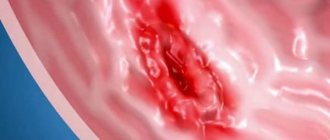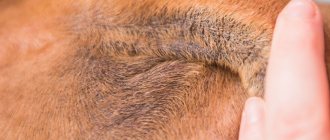If we are talking about the most important organs in the human or animal body, then everyone remembers the brain and heart, but for some reason they forget the liver. But in vain, because the liver is a large organ that performs a number of vital functions. It is extremely important for the dog’s health, so even minor deviations in work can lead to irreversible consequences. Therefore, liver diseases in dogs need to be treated promptly, as they are extremely dangerous to the health and life of the pet.
Liver diseases in dogs
Basic liver functions
The unique properties of the liver lie in its regenerative abilities. Even with serious damage to this organ, when more than 70% of the cells do not work, the liver always recovers. But this is not always good, since an animal, being in a critical condition, can feel excellent and not encounter any external manifestations. To put it another way, serious problems can arise with diagnosing the liver in animals.
Location of the liver in dogs
Various liver diseases manifest themselves in the form of symptoms quite late, so periodic examinations by a veterinarian play an important role, allowing one to identify all kinds of health problems at an early stage of their development. But in some cases, a biopsy is required to diagnose a particular disease. This procedure is painful, but very effective.
Liver shunts in dogs
Reasons for the development of pathologies
The occurrence of chronic liver diseases in dogs is often associated with long-term inflammatory processes, the course of which negatively affects the entire body, impairing the functioning of the bile ducts. A weakened immune system also affects morbidity.
Note! Many diseases, including cancer, can have a detrimental effect on the condition of an animal’s liver. Cancer of any internal organs greatly reduces the functionality of the liver.
Refusal to eat is an important symptom of illness in dogs.
We also cannot exclude anatomical disorders, which often cause malfunction of some internal organs. One of the most common liver diseases is hepatitis. It occurs against the background of the activity of protozoan parasites or the harmful effects of toxic compounds.
Infectious hepatitis includes:
- panleukopenia (a viral disease that often occurs in cats and dogs);
- colibacillosis or, as it is also called in medicine, escherichiosis (an acute infectious disease);
- leptospirosis;
- salmonellosis (acute intestinal infection);
- listeriosis (a bacterial infection caused by listeria);
- parvovirus enteritis;
- Carré's disease (canine plague).
Carré's disease is a deadly disease in domestic animals.
The development of the second group of hepatitis can be provoked by:
- chemicals such as mercury, arsenic, nitrates or nitrites;
- poisonous plants;
- spoiled dog food;
- toxic substances of various fungi, viruses or pathogenic microorganisms.
There are liver pathologies that occur due to improper use of potent drugs. Most often this happens due to the use of antiparasitic or insecticidal drugs, serums or immunostimulants.
Etiology, causes
As already noted, primary cancers in the liver, which are formed from the organ’s own pathological cellular structures, are diagnosed less frequently in dogs. As a rule, secondary (metastatic) tumors are noted that penetrate from other organs affected by the cancer process. In this case, cancer cells can migrate to the liver through the lymphohematogenous route.
Possible causes of oncology:
- gene mutations, age-related changes;
- genetic predisposition;
- radioactive, radiation exposure;
- long-term use of certain medications;
- effects on the liver of potent poisons, toxins, chemical reagents;
- chronic pathologies in the gastrointestinal tract;
- viral, parasitic diseases (schistomiasis, trematodiasis, opisthorchiasis);
- autoimmune diseases.
The development of the disease is preceded by hemochromatosis (increased concentration of iron in the blood), chronic liver pathologies (cirrhosis, hepatitis). In dogs, liver cancer can develop against the background of viral hepatitis, severe helminthic infestation (liver parasites), or cholelithiasis.
Metastatic liver cancer in dogs in most cases develops as a result of adenocarcinoma of the mammary glands, malignant hemangioma of the spleen, and pancreatic cancer.
Liver cancer can develop in dogs of any breed and age, but older animals are most susceptible to cancer.
Classification of diseases
Every day, the liver is subjected to serious stress, purifying food from various toxins, neutralizing foreign substances, participating in the synthesis of useful substances, etc. Therefore, many diseases of the liver, which is the most important organ in the body, can significantly disrupt the life cycle of animals. Below are the most common pathologies.
Fatty liver disease in dogs
Table. Common Liver Diseases in Dogs
| Name of the disease | Description |
| Hepatitis | A viral pathology that is often transmitted through food. Manifests itself in the form of disruption of the liver and central nervous system, catarrhal inflammation of the mucous membrane and fever. Your dog may also experience diarrhea or vomiting. Hepatitis therapy consists of using antibiotics and following a special diet (excluding fatty foods, adding special herbal decoctions to normalize digestion) |
| Leptospirosis | A common infectious pathology that can affect not only the animal’s liver, but also other organs, such as the kidneys. Characteristic symptoms of leptospirosis include changes in the color of urine, fever, loss of appetite, and the formation of ulcers on the oral mucosa. When treating leptospirosis, the animal is prescribed hyperimmune serum and strong antibacterial drugs. To normalize the dog’s condition, doctors administer hepatoprotective and anticonvulsant drugs intravenously |
| Mycosis | Another liver disease. This is a fungal infection that can be contracted through household items. Fungi are the causative agents of the disease. The disease manifests itself in the form of the formation of gray crusts on the affected areas of the skin, the appearance of foci of inflammation, enlarged tonsils and loss of tufts of hair. Treatment of mycosis in dogs must be comprehensive, so doctors prescribe the use of systemic antifungal drugs, for example, Ketoconazole and Nystatin, anti-trichophytosis vaccines and anti-inflammatory drugs |
| Pancreatitis | An inflammatory disease of the pancreas that also affects the liver. Signs of pancreatitis include decreased appetite, dehydration, shortness of breath and bloating. Treatment of pancreatitis takes place on an outpatient basis. During the first 24 hours, the pet must follow a strict diet. If there is a risk of dehydration, the doctor will administer saline solutions intravenously. In rare cases, probiotics and antibiotics are used |
| Heart failure | This pathology does not affect the animal’s liver, but directly affects its condition. In heart failure, the liver will not receive the required amount of oxygen, causing liver cells to begin to die. The pathology is accompanied by coughing attacks, a sharp increase in the animal’s weight, blue discoloration of the mucous membranes and shortness of breath. During treatment, diuretics (Furosemide, Veroshpiron), cardiac glycosides, for example, Digoxin, as well as inhibitors (Enalapril) are prescribed. |
Regardless of the type of liver disease, when treating pets, therapeutic nutrition is used, medications are taken to eliminate signs of intoxication, and the veterinarian also places a taboo on all kinds of physical activity.
Video - Liver failure in dogs
Diseases associated with medications
As noted earlier, liver diseases in animals can occur due to the use of certain potent drugs. Below are the most commonly diagnosed ones.
Cushing's disease
A neuroendocrine disease that occurs when there is an increased level of the stress hormone in the blood (cortisol). As a rule, the disease develops with prolonged and uncontrolled use of painkillers and hormonal drugs. Against the background of the emerging pathological process, hepatitis may develop.
Symptoms of Cushing's disease in dogs
Characteristic symptoms of the disease include:
- sagging abdomen;
- decreased muscle tone;
- general weakness of the body;
- frequent urination;
- increased thirst.
Once the diagnosis is confirmed, the veterinarian will prescribe medication, which is done in most cases. Drugs such as Cyproheptadine, Ketoconazole, Lysodren, Mitotane and others are prescribed. But if an adrenal tumor is detected, then the doctor is forced to resort to surgery, during which the affected adrenal gland is removed.
Dog with Cushing's disease
Ascites
Abdominal hydrops or ascites is a pathological condition in which free fluid accumulates in the abdominal cavity. In most cases, this disease is directly related to liver failure. Characteristic symptoms of ascites include an increase in the volume of the dog’s abdominal cavity: the animal looks like a large ball with legs and a tail. But this only happens in severe cases.
Basically, ascites causes increased gas formation, shortness of breath, tissue swelling, decreased activity, muscle atrophy and bouts of vomiting. If the pathology is accompanied by an infectious process, then antibacterial drugs are used in treatment. Also, for ascites, therapeutic abdominocentesis is performed, diuretics and oxygen therapy are prescribed. These measures will eliminate the unpleasant symptoms of the disease.
Ascites is a pathological condition in which free fluid accumulates in the abdominal cavity
Cirrhosis
A common liver disease that acts as the end result of a chronic form of hepatitis. Cirrhosis is accompanied by necrosis of liver cells, scarification and the development of an inflammatory process. Also, with cirrhosis of the liver, the dog loses appetite, visual acuity decreases, attacks of diarrhea or constipation occur, ulcers and dermatitis appear on the skin.
There is no treatment, so veterinarians prescribe maintenance therapy, including detoxification therapy, the use of hepatoprotectors and choleretic drugs. To alleviate the dog's condition, it is necessary to make some adjustments to his diet. Experts recommend eliminating completely fatty foods, giving preference to healthy foods rich in proteins and slow carbohydrates.
Liver affected by cirrhosis
Types of colic in dogs
Depending on the location of the spasm, veterinary medicine usually distinguishes between the following types of colic in dogs: intestinal, gastric, renal and hepatic.
- Spasmodic contractions caused by diseases of the digestive system are classified as true colic.
- Pathologies of the kidneys , liver, parasitic and bacterial infections cause false colic.
- True intestinal colic most often occurs in young animals after weaning from their mother due to stress and a change in diet, overfeeding or improper feeding.
- False renal and hepatic painful attacks can occur in animals of any age.
Intestinal colic
Most often, dogs are diagnosed with intestinal colic, accompanied by painful spasms of the smooth muscles of the animal's intestines. The root cause is pathological processes that irritate the nerve endings of the intestinal walls.
Colic caused by a violation of the diet: overfeeding, poisoning, changing the diet, eating low-quality food, goes away on its own after eliminating unfavorable factors or detailed correction of the diet.
Intestinal colic occurs against the background of intestinal infections, parasitic diseases, inflammatory and destructive processes, foreign bodies and neoplasms. These cases require complex treatment aimed at eliminating the cause of the disease and relieving painful symptoms.
Often, spasms of intestinal smooth muscles are caused by abdominal trauma or congenital anomalies in the structure of an internal organ. Sometimes intestinal colic develops as a result of inflammation of the lymph nodes of the abdominal cavity against the background of respiratory infections.
Hepatic colic
Acute spastic pain in the right hypochondrium in an animal indicates hepatic colic. Painful symptoms in dogs most often occur due to blockage of the bile duct by stones or compression of them by a neoplasm.
The cause of pain can also be parasites that destroy the liver parenchyma. Hepatic colic develops when animals consume fatty, fried or spicy foods, against the background of cholecystitis, gastritis, pancreatitis and duodenitis. It is possible to accurately determine the location and cause of spasms only in a veterinary clinic.
Renal colic
Convulsive painful contractions of the smooth muscles of the kidneys or ureters develop with renal colic. Due to various reasons, difficulty or impossibility of urine outflow from the kidneys occurs, leading to the accumulation of urine in the renal pelvis. Acute painful sensations are observed against the background of irritation of the nerve endings of the wall of the ureters, compression of blood vessels and swelling of the kidneys.
The cause of renal colic is urolithiasis, acute pyelonephritis, nephroptosis, cystitis, renal vein thrombosis and renal tuberculosis. Obstruction of urine outflow occurs when the kidneys are compressed by abdominal hematomas or tumors of the kidneys, ureter or prostate gland.
IMPORTANT!!! Renal colic is the worst tolerated, the animal can die from painful shock.
Stomach colic
Acute stomach pain is caused by expansion of the stomach, which causes irritation of the nerve endings of the digestive organ. Acute dilatation of the stomach occurs in young animals when transferring pets from breast milk to constant food; the chronic form is typical for older dogs.
Gastric colic occurs as a result of an increase in the volume of the stomach against the background of a violation of its secretory and motor functions and spasm of the pylorus, resulting in the accumulation of gases, liquids and food in the lumen of the digestive organ. An enlarged stomach puts pressure on the diaphragm, heart and lungs, causing severe pain, breathing problems, blood circulation and metabolism.
The causes of stomach colic are a change in diet, overfeeding, greedy eating, eating spoiled food, stress, and mechanical intestinal obstruction. Sometimes excessive physical activity after a heavy meal and injury to the spinal column leads to spastic contraction of the smooth muscles of the stomach.
Malignant liver lesions
The primary form of liver cancer, according to experts, can develop against the background of the negative influence of carcinogenic factors (heavy metal derivatives, FOS, COS, aflatoxins and others) or be the result of other liver diseases, for example, cirrhosis.
Histologically, liver neoplasms can be divided into the following:
- hemangiosarcoma is a tumor of vascular origin. It manifests itself in the form of general weakness of the body, an increase in the size of the abdomen, paleness of the mucous membranes and general weakness of the animal’s body. In most cases, hemangiosarcoma is treated with surgery, in which the doctor removes the tumor. Chemotherapy may be used as an alternative;
- Infantile hemangioma is a benign formation that occurs primarily on the extremities and trunk. Hemangioma is a small reddish plaque. The disease is not accompanied by characteristic symptoms, so such tumors are usually discovered by accident during bathing. Treatment of hemangioma is surgical. The tumor is removed using a scalpel or cryotherapy;
- fibrosarcoma is a malignant tumor that develops from connective tissue. The disease develops against the background of hormonal changes, infection, negative effects of radiation, etc. Depending on the location of the tumor, symptoms may vary. For example, if fibrosarcoma occurs on the extremities, then the dog’s gait may be impaired, swelling of the paws, and pain may appear. When a tumor appears in the mouth, the animal loses its appetite and profuse salivation occurs. Treatment for fibrosarcoma is only surgical, since drug therapy will not help get rid of the tumor.
Liver cancer in dogs
On a note! Metastases, or secondary formations, are diagnosed much more often and develop against the background of malignant formations of bones, mammary glands, organs of the respiratory system or abdominal cavity.
Liver diseases in dogs: symptoms and treatment
Symptoms and treatment of liver disease in dogs depend on the type of disease.
| Hepatopathy | Symptoms | Treatment |
| Organ inflammation. Hepatitis is damage to cells due to the introduction of bacteria, viruses, fungi, etc. |
|
|
| Fibrosis . The pathology is the replacement of hepatocytes with fibrous tissue without changing the cell structure. |
|
|
| Hepatosis . The disease is characterized by dystrophic changes in the parenchyma of the organ. |
|
|
| Lipidosis is a fatty degeneration of liver cells. |
|
|
| Liver failure – irreversible changes in the structure of the organ. |
| |
| Cirrhosis represents irreversible changes in hepatocytes caused by the proliferation of connective tissue. |
|
|
| Cholestasis is a blockage of the bile ducts, which makes it difficult for the evacuation of bile from the liver to the small intestine. |
| |
| Liver cancer – irreversible changes in the hepatobiliary system of the organ. | The clinical picture of the tumor is nonspecific and largely depends on the type of cancer:
| In the absence of metastases, surgical removal of the tumor and part of the organ is indicated. In some cases, radiation and chemotherapy are prescribed for the disease. |
| Hepatic colic are a consequence of bile duct obstruction. |
|
|
| Fibrofatty changes represent fatty degeneration of the hepatobiliary structure of the organ. | Symptoms are uncharacteristic: decreased appetite and activity of the pet, periodic bowel irregularities, intoxication phenomena. |
|
| Liver failure in dogs it is an irreversible process of destruction of hepatocytes. |
| Treatment is symptomatic and aimed at detoxifying the body. |
Characteristic symptoms
Liver diseases at an early stage of development in dogs are practically invisible, as they are not accompanied by pronounced symptoms. But still, owners may notice a change in their pet’s behavior:
- strong thirst;
- sudden weight fluctuations;
- decreased or complete loss of appetite;
- state of apathy, general weakness of the body.
A state of apathy is a signal of a dog’s illness
If you notice a problem in your pet that lasts for several days, you should immediately seek help from a specialist. Only an experienced veterinarian will be able to determine the exact cause of the pathological condition and make an accurate diagnosis.
As the disease develops, the animal’s condition may deteriorate noticeably, and new symptoms will be added to the existing signs:
- increased body temperature;
- dry mucous membranes;
- peeling of the skin;
- an increase in the size of the liver (noted on palpation);
- pain in the abdominal area;
- the appearance of flatulence;
- change in stool color (stool becomes grayish);
- bowel dysfunction (alternating constipation with diarrhea);
- attacks of nausea and vomiting;
- change in the dog’s behavior (the animal may become more affectionate and obedient or, conversely, aggressive).
Note! Severe liver disease is often accompanied by loss of smell or vision. The dog begins to move uncertainly due to lack of coordination. Animals often develop mental disorders, which affects their behavior.
Video - Liver diseases in cats and dogs
Diagnostic features
If a dog is suspected of having liver disease, a veterinarian will conduct a diagnostic examination to make an accurate diagnosis. But, in addition to visual examination or palpation, which the doctor performs at the very beginning of the examination, other procedures may be required:
- stool flotation test;
- laboratory urine analysis;
- biochemical analysis for the presence of GGT, alkaline phosphate, bilirubin, glucose and electrolytes;
- general blood analysis.
If a dog is suspected of having liver disease, a veterinarian will conduct a diagnosis
Based on the research results obtained, the doctor will be able to make an accurate diagnosis. If necessary, additional diagnostic procedures may be prescribed, such as ultrasound, abdominal x-ray. These measures make it possible to assess the size of the affected liver, its density and shape. Only after making a diagnosis, the doctor prescribes an appropriate course of therapy.
The most popular drugs for treating the liver in dogs in uncomplicated cases
Veterinarians prescribe the following medications to treat liver disease in dogs:
- Antispasmodics. To relieve spasms of the smooth muscles of the bile ducts, No-shpa, Papaverine, and Atropine are used. The drugs also have an analgesic effect.
- Choleretic agents: Allochol, dehydrocholic acid, Cholenzyme. Corn silk and immortelle flowers increase the secretion of bile, promote its dilution and evacuation.
- Magnesium sulfate and Carlsbad salt are prescribed to cleanse the bile ducts.
- Of the antiemetics, Cerucal is most often used.
- Hepatoprotectors – Hepatiale forte, Hepavex, Hepatovet, Hepato-lux.
How to treat?
Depending on the diagnosis, the therapeutic course may vary. But it must include:
- choleretic drugs;
- hepatoprotectors (intended to protect the liver);
- painkillers and antipyretics;
- plasma-substituting drugs (prescribed for a sharp decrease in the dog’s weight);
- antitoxic drugs (used in the treatment of severe stages of the disease, as well as for various types of poisoning of the body);
- antibiotics (prescribed in cases where liver disease is viral in nature).
The treatment regimen depends on the nature of the disease
During the therapeutic course, all actions must be carried out under the strict supervision of the attending physician. It is possible that additional blood tests may be required during treatment to evaluate the therapeutic effect of the drugs used. Self-medication is strictly not recommended, as this can seriously harm your pet.
Liver pathology can occur due to food poisoning. In this case, it is enough to lavage the stomach using special solutions. The effectiveness of washing is possible only if this procedure is performed at an early stage of the development of the disease.
Self-medication is strictly not recommended
On a note! If the animal has been diagnosed with liver failure, then in this case, doctors perform intracavitary surgery, due to which blood flow is redirected through the affected liver. This allows you to stop intoxication.
Treatment and proper nutrition for illness
Treatment of colic in dogs
It is highly not recommended to independently diagnose the cause of colic and prescribe therapeutic measures; even the most experienced doctor, to determine the etiology of spasms, conducts a comprehensive examination using laboratory tests of blood, urine and feces, examination, ultrasound and radiography. Based on the results of the examination, appropriate treatment for colic in dogs is prescribed, aimed at eliminating the cause of spasms of the smooth muscles of the internal organs and relieving pain.
Depending on the etiology, animals are prescribed antibacterial, antiparasitic, antispasmodic, hormonal, painkillers, hepatoprotective, anti-inflammatory drugs, vitamins and probiotics. An important component of proper treatment is a diet consisting of fasting with the gradual introduction of easily digestible foods into the diet.
Proper nutrition
Regardless of the type of liver disease, in parallel with drug treatment, the doctor prescribes a special diet, the observance of which can reduce or completely eliminate the negative effects of toxins that remain after the breakdown of food.
The diet allows you to reduce or completely eliminate the negative impact of toxins that remain after the breakdown of food
Proper nutrition for liver diseases in dogs consists of following the following recommendations:
- The dog’s daily diet should contain easily digestible carbohydrates and quickly broken down sources of proteins;
- the number of meals should be at least 4 per day (preferably from 4 to 6 meals);
- monitor not only the quality, but also the quantity of food (your pet should not lose weight);
- If possible, use ready-made dietary dog food.
If you have any questions regarding nutrition, please contact your doctor. He will definitely advise you on this or that issue, which will greatly simplify treatment.
Video - How to feed dogs correctly?
Prevention measures
In order not to encounter various liver diseases in the future and to protect your dog from all kinds of problems, it is necessary to follow several preventive measures:
- provide your pet with adequate nutrition, watch what your dog eats (food should only be fresh);
- prevent all kinds of contact of the dog with toxic substances that can harm its health. First of all, we are talking about arsenic, rat poison and other substances;
- Periodically deworm the animal (cleanse it from worms). It is advisable to carry out such cleanings at least 2 times a year;
- Carry out diagnostic examinations with a veterinarian. This should be done even in the absence of any health problems with the animal;
- get vaccinated. This will prevent various diseases.
To prevent diseases in dogs, it is necessary to conduct diagnostic examinations by a veterinarian.
It is much easier to prevent liver disease than to cure it, so taking preventive measures is an important step in your pet's life.











